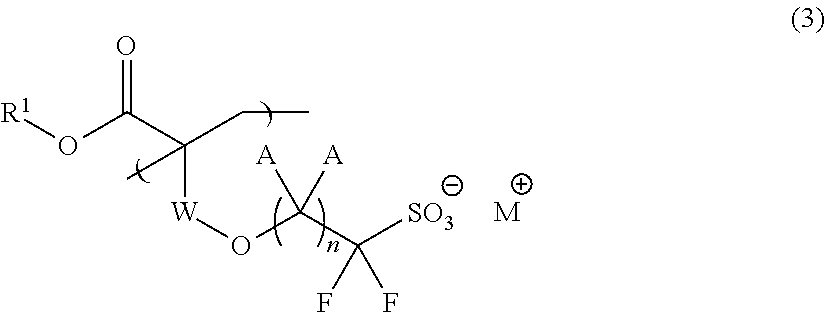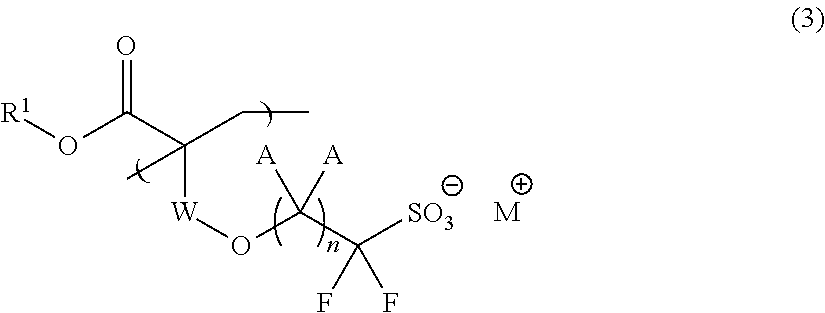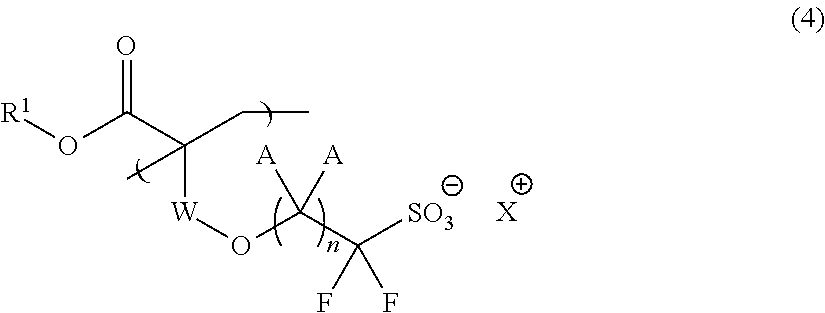Fluorine-Containing Sulfonate, Fluorine-Containing Sulfonate Resin, Resist Composition and Pattern Formation Method
a technology of fluorine-containing sulfonate and resist, which is applied in the direction of photosensitive materials, instruments, photomechanical equipment, etc., can solve the problems of pattern formation roughness, pattern deficiency, pattern formation failure, etc., and achieves the effect of changing the solubility of the developer, avoiding lack of uniformity, and high sensitivity
- Summary
- Abstract
- Description
- Claims
- Application Information
AI Technical Summary
Benefits of technology
Problems solved by technology
Method used
Image
Examples
synthesis example 1
2-[2-(t-Butoxycarbonyl)allyloxy]-1,1-difluoroethanesulfonic acid triphenylsulfonium
[0251]
Synthesis of Target Compound (PAG-1)
[0252]In a 100-ml flask, 31 g of an aqueous solution of 5 mass % sodium hydroxide was placed. The solution was cooled, with stirring, by immersing the flask in an ice water bath. Then, 15.0 g of 2-hydroxy-1,1-difluoroethanesulfonic acid triphenylsulfonium (purity: 95%, 0.035 mol) was gradually added to the solution. The solution was returned to room temperature and stirred for 30 minutes. The solution was again cooled by immersing the flask in the ice water bath. After that, a solution of 6.5 g of tert-butyl 2-bromomethylacrylate (0.029 mol) in 10 g of acetonitrile was dropped into the above solution. The mixed solution was further stirred for 1.5 hours at room temperature. The thus-obtained reaction solution was separated into upper and lower layers. The lower layer was mixed with 20 g of chloroform and washed three times with 24 g of water. The resulting sol...
synthesis example 2
2-[2-(2-Methyladamantaneoxycarbonyl)allyloxy]-1,1-difluoroethanesulfonic acid triphenylsulfonium
[0255]
Synthesis of Target Compound (PAG-2)
[0256]In a 500-ml three-neck flask, 39.8 g (45.6 mmol) of an aqueous solution of 5% sodium hydroxide and 16.1 g (38.0 mmol) of 2-hydroxy-1,1-difluoroethanesulfonic acid triphenylsulfonium were placed. The resulting solution was stirred for 10 minutes at room temperature, thereby completely dissolving the solid substance. Subsequently, 25 g of crude 2-methyladamantyl 2-[(methanesulfonyloxy)methyl]acrylate was dropped and mixed into the solution. The mixed solution was then stirred for 1 hour at room temperature. After the completion of the reaction, the thus-obtained reaction solution was separated into an aqueous layer and a target product layer. The aqueous layer was extracted with 45 g of chloroform. The target product layer was combined with the chloroform extract. The combined product layer was washed five times with 45 g of water, washed twic...
synthesis example 3
[0259]
Synthesis of Target Compound (PAG-3)
[0260]In a 500-ml three-neck flask, 39.8 g (45.6 mmol) of an aqueous solution of 5% sodium hydroxide and 16.1 g (38.0 mmol) of 2-hydroxy-1,1-difluoroethanesulfonic acid triphenylsulfonium were placed. The resulting solution was stirred for 10 minutes at room temperature, thereby completely dissolving the solid substance. Subsequently, 20 g of crude 1-methylcyclopentyl 2-[(methanesulfonyloxy)methyl]acrylate was dropped and mixed into the solution. The mixed solution was then stirred for 1 hour at room temperature. After the completion of the reaction, the thus-obtained reaction solution was separated into an aqueous layer and a target product layer. The aqueous layer was extracted with 45 g of chloroform. The target product layer was combined with the chloroform extract. The combined product layer was washed five times with 45 g of water, washed twice with 30 g of 0.1N hydrochloric acid and further washed twice with 45 g of water. The washed ...
PUM
| Property | Measurement | Unit |
|---|---|---|
| Nanoscale particle size | aaaaa | aaaaa |
| Nanoscale particle size | aaaaa | aaaaa |
| Wavelength | aaaaa | aaaaa |
Abstract
Description
Claims
Application Information
 Login to View More
Login to View More - R&D
- Intellectual Property
- Life Sciences
- Materials
- Tech Scout
- Unparalleled Data Quality
- Higher Quality Content
- 60% Fewer Hallucinations
Browse by: Latest US Patents, China's latest patents, Technical Efficacy Thesaurus, Application Domain, Technology Topic, Popular Technical Reports.
© 2025 PatSnap. All rights reserved.Legal|Privacy policy|Modern Slavery Act Transparency Statement|Sitemap|About US| Contact US: help@patsnap.com



